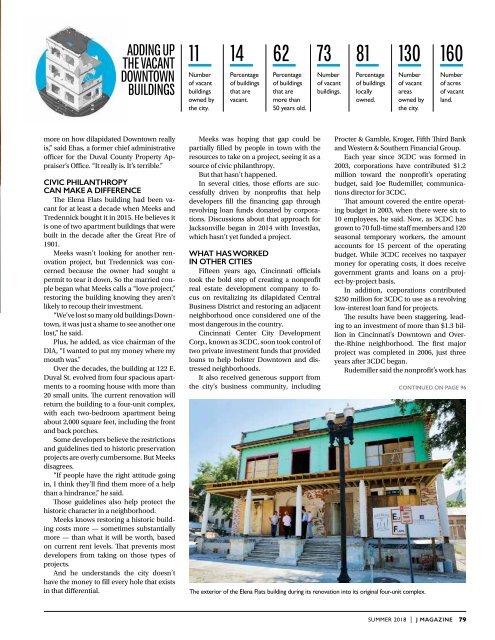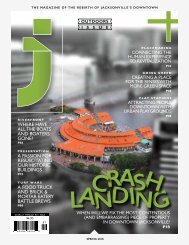J Magazine Summer 2018
The magazine of the rebirth of Jacksonville's downtown
The magazine of the rebirth of Jacksonville's downtown
Create successful ePaper yourself
Turn your PDF publications into a flip-book with our unique Google optimized e-Paper software.
ADDING UP<br />
THE VACANT<br />
DOWNTOWN<br />
BUILDINGS<br />
11<br />
Number<br />
of vacant<br />
buildings<br />
owned by<br />
the city.<br />
14<br />
Percentage<br />
of buildings<br />
that are<br />
vacant.<br />
62<br />
Percentage<br />
of buildings<br />
that are<br />
more than<br />
50 years old.<br />
73<br />
Number<br />
of vacant<br />
buildings.<br />
81<br />
Percentage<br />
of buildings<br />
locally<br />
owned.<br />
130<br />
Number<br />
of vacant<br />
areas<br />
owned by<br />
the city.<br />
160<br />
Number<br />
of acres<br />
of vacant<br />
land.<br />
more on how dilapidated Downtown really<br />
is,” said Ehas, a former chief administrative<br />
officer for the Duval County Property Appraiser’s<br />
Office. “It really is. It’s terrible.”<br />
Civic philanthropy<br />
can make a difference<br />
The Elena Flats building had been vacant<br />
for at least a decade when Meeks and<br />
Tredennick bought it in 2015. He believes it<br />
is one of two apartment buildings that were<br />
built in the decade after the Great Fire of<br />
1901.<br />
Meeks wasn’t looking for another renovation<br />
project, but Tredennick was concerned<br />
because the owner had sought a<br />
permit to tear it down. So the married couple<br />
began what Meeks calls a “love project,”<br />
restoring the building knowing they aren’t<br />
likely to recoup their investment.<br />
“We’ve lost so many old buildings Downtown,<br />
it was just a shame to see another one<br />
lost,” he said.<br />
Plus, he added, as vice chairman of the<br />
DIA, “I wanted to put my money where my<br />
mouth was.”<br />
Over the decades, the building at 122 E.<br />
Duval St. evolved from four spacious apartments<br />
to a rooming house with more than<br />
20 small units. The current renovation will<br />
return the building to a four-unit complex,<br />
with each two-bedroom apartment being<br />
about 2,000 square feet, including the front<br />
and back porches.<br />
Some developers believe the restrictions<br />
and guidelines tied to historic preservation<br />
projects are overly cumbersome. But Meeks<br />
disagrees.<br />
“If people have the right attitude going<br />
in, I think they’ll find them more of a help<br />
than a hindrance,” he said.<br />
Those guidelines also help protect the<br />
historic character in a neighborhood.<br />
Meeks knows restoring a historic building<br />
costs more — sometimes substantially<br />
more — than what it will be worth, based<br />
on current rent levels. That prevents most<br />
developers from taking on those types of<br />
projects.<br />
And he understands the city doesn’t<br />
have the money to fill every hole that exists<br />
in that differential.<br />
Meeks was hoping that gap could be<br />
partially filled by people in town with the<br />
resources to take on a project, seeing it as a<br />
source of civic philanthropy.<br />
But that hasn’t happened.<br />
In several cities, those efforts are successfully<br />
driven by nonprofits that help<br />
developers fill the financing gap through<br />
revolving loan funds donated by corporations.<br />
Discussions about that approach for<br />
Jacksonville began in 2014 with InvestJax,<br />
which hasn’t yet funded a project.<br />
What has worked<br />
in other cities<br />
Fifteen years ago, Cincinnati officials<br />
took the bold step of creating a nonprofit<br />
real estate development company to focus<br />
on revitalizing its dilapidated Central<br />
Business District and restoring an adjacent<br />
neighborhood once considered one of the<br />
most dangerous in the country.<br />
Cincinnati Center City Development<br />
Corp., known as 3CDC, soon took control of<br />
two private investment funds that provided<br />
loans to help bolster Downtown and distressed<br />
neighborhoods.<br />
It also received generous support from<br />
the city’s business community, including<br />
Procter & Gamble, Kroger, Fifth Third Bank<br />
and Western & Southern Financial Group.<br />
Each year since 3CDC was formed in<br />
2003, corporations have contributed $1.2<br />
million toward the nonprofit’s operating<br />
budget, said Joe Rudemiller, communications<br />
director for 3CDC.<br />
That amount covered the entire operating<br />
budget in 2003, when there were six to<br />
10 employees, he said. Now, as 3CDC has<br />
grown to 70 full-time staff members and 120<br />
seasonal temporary workers, the amount<br />
accounts for 15 percent of the operating<br />
budget. While 3CDC receives no taxpayer<br />
money for operating costs, it does receive<br />
government grants and loans on a project-by-project<br />
basis.<br />
In addition, corporations contributed<br />
$250 million for 3CDC to use as a revolving<br />
low-interest loan fund for projects.<br />
The results have been staggering, leading<br />
to an investment of more than $1.3 billion<br />
in Cincinnati’s Downtown and Overthe-Rhine<br />
neighborhood. The first major<br />
project was completed in 2006, just three<br />
years after 3CDC began.<br />
Rudemiller said the nonprofit’s work has<br />
The exterior of the Elena Flats building during its renovation into its original four-unit complex.<br />
CONTINUED ON PAGE 96<br />
SUMMER <strong>2018</strong> | J MAGAZINE 79
















